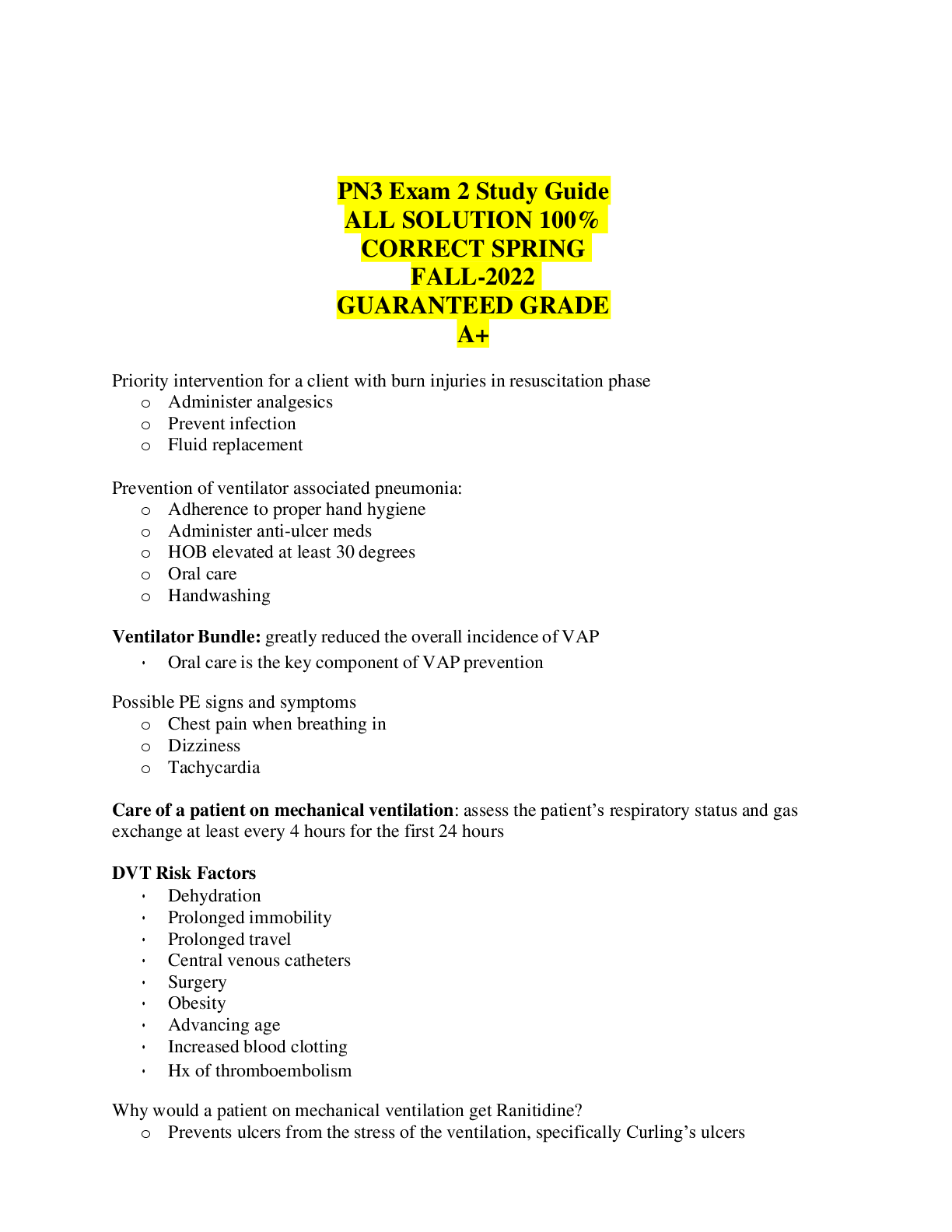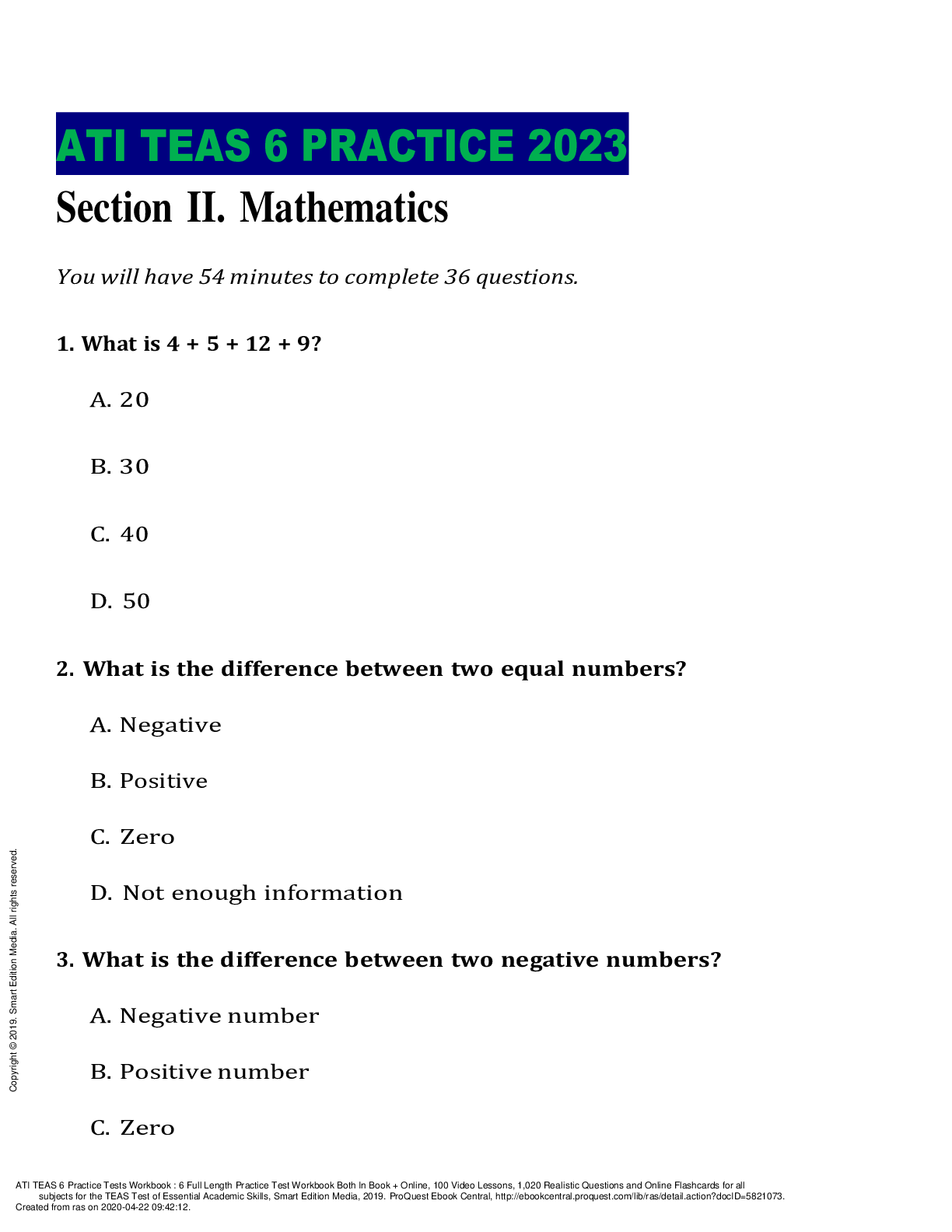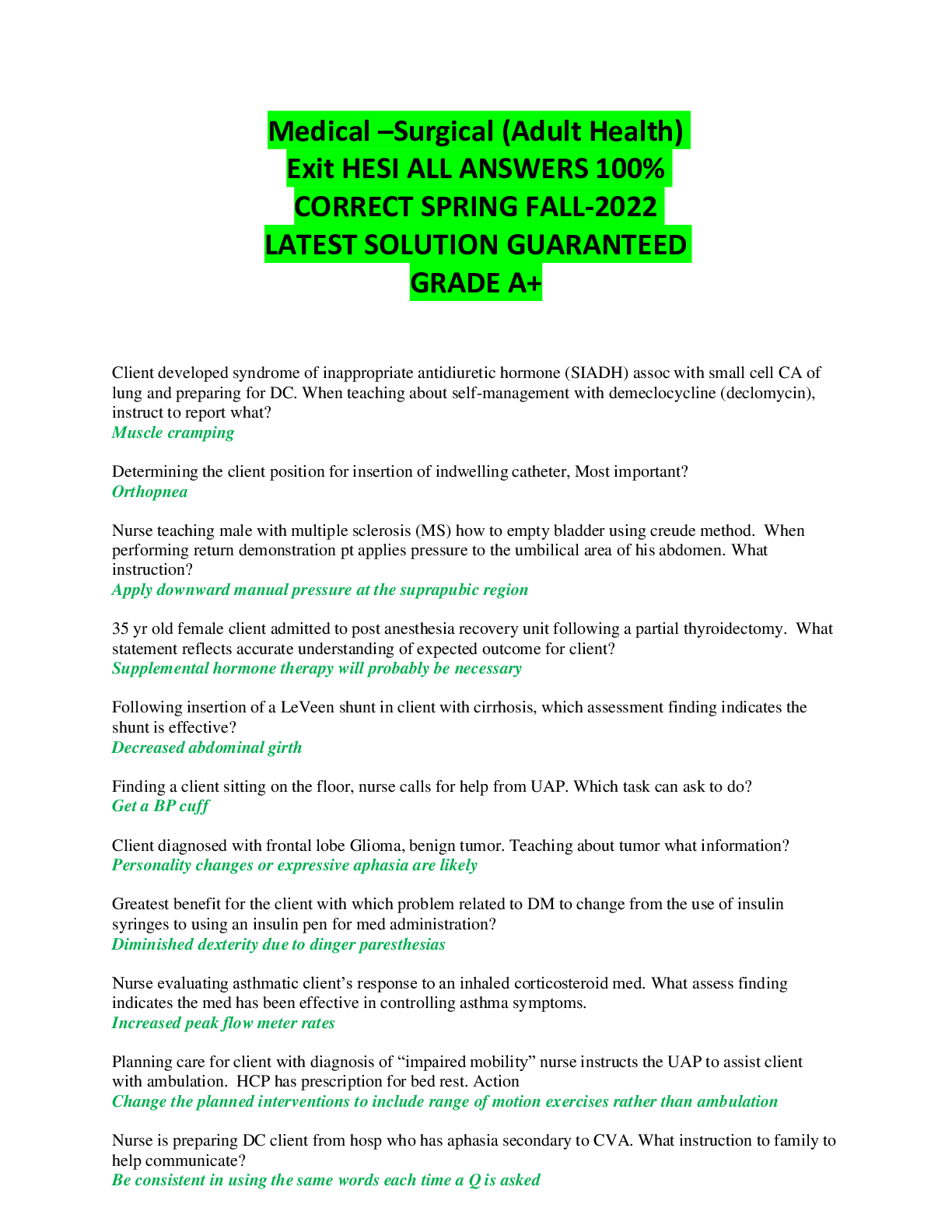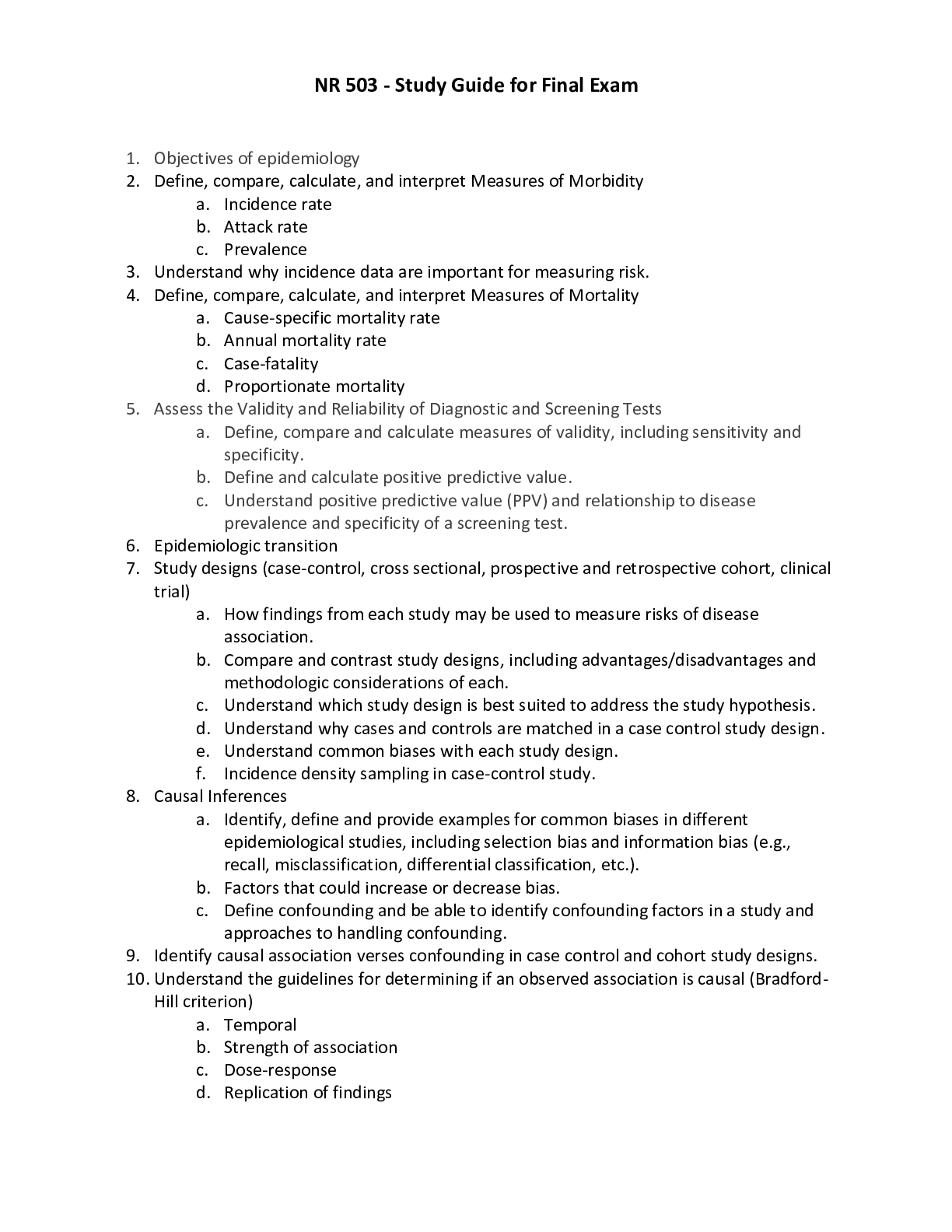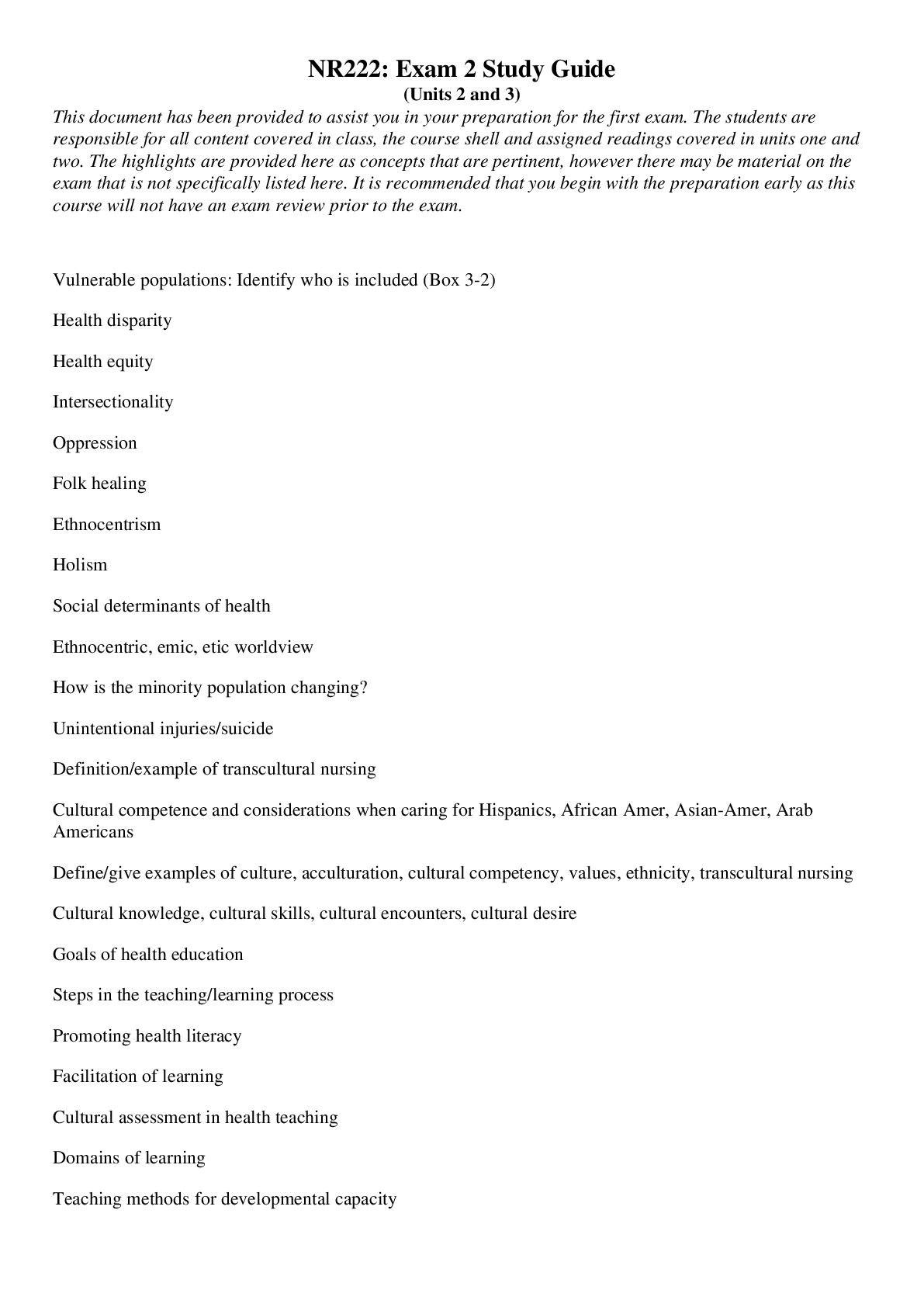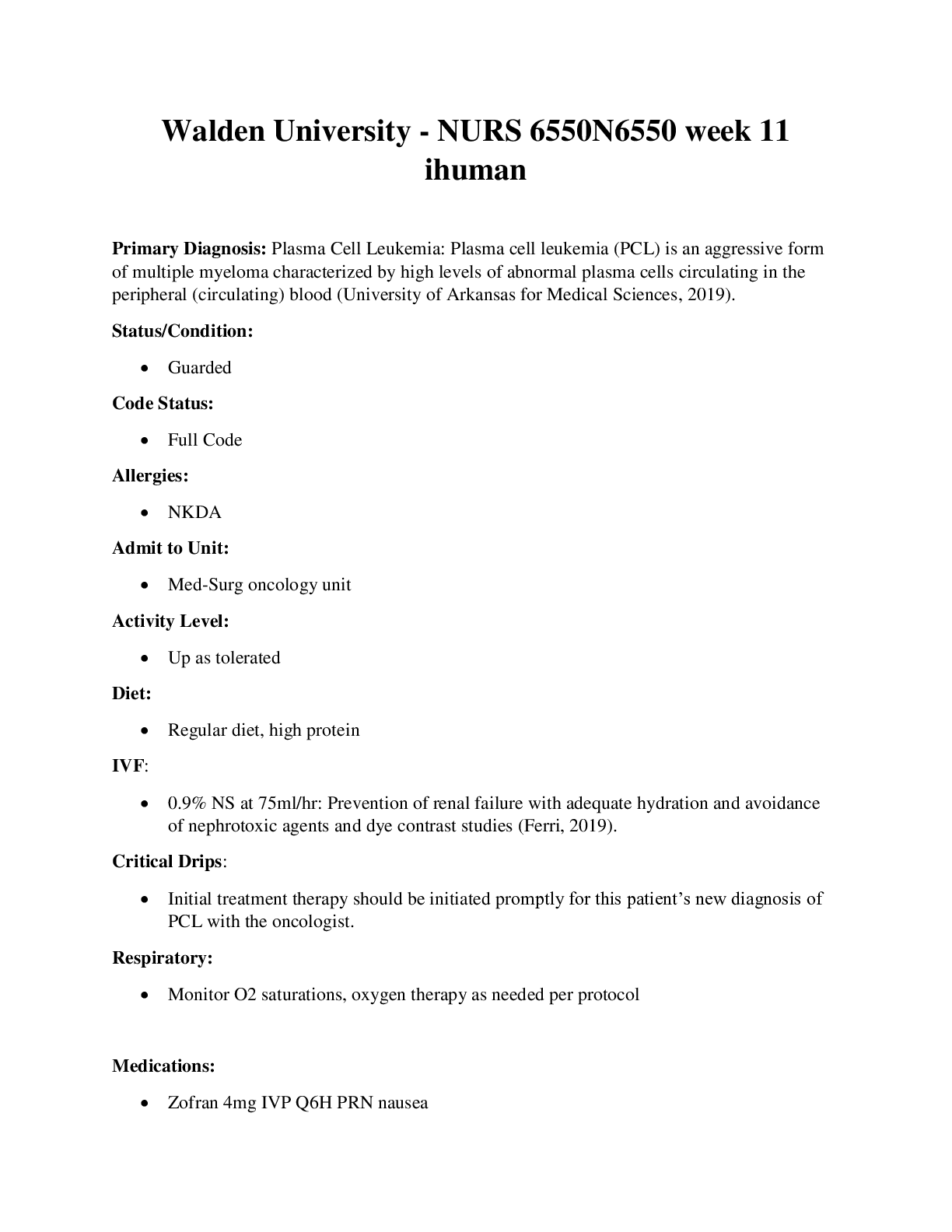*NURSING > STUDY GUIDE > Peds-Exam 2 STUDY GUIDE 100% CORRECT ANSWERS GUARANTEE GRADE A+ (All)
Peds-Exam 2 STUDY GUIDE 100% CORRECT ANSWERS GUARANTEE GRADE A+
Document Content and Description Below
HEMATOLOGIC DISORDERS: 7-10 questions • Identify general nursing strategies associated with altered anemia • Describe the morphology, pathophysiology, clinical manifestations, therapeutic manage... ment and nursing considerations of the following anemias: o ***Laboratory norms: 6-12 years of age ▪ Hemoglobin: • 11.5-15.5 g/dl ▪ Hematocrit: • 35-45% ▪ MCV (mean corpuscular volume) • 77-95 fL • Measure of average size of RBC • ↓ in microcytic; ↑ in macrocytic ▪ MCHC (mean corpuscular Hgb concentration) • 31–37 g/dl • Reflection of Hgb concentration • Refer to color; in hypo-, values are ↓ ▪ MCH (mean corpuscular Hgb) • 25–33 pg/cell • Reflection of Hgb concentration • Refer to color; in hypo-, values are ↓ o Anemia ▪ Condition where the hemoglobin content of the blood is insufficient to satisfy bodily needs ▪ Causes: • Blood loss • Accelerated hemolysis • Decreased production ▪ Typical Clinical Manifestations: • Fatigue • Dizziness • Weakness • Pallor • ↑ heart rate • ↑ breathing rate o Types: ▪ Iron-deficiency anemia—MOST COMMON IN PEDS • Nutritional anemia • Microcytic-hypochromic—small, pale RBC • Who’s at risk? o Varied o Premature babies at ↑ risk b/c they don’t get that blood rush the mom gives the baby late in that 3rd trimester, b/c premies are born early—this is why premature infants need the iron supplements at 2-3 months, whereas term babies don’t need it until 4-6 months o Multiples and twins at ↑ because only finite amount of blood available in that last rush of blood; so not all the babies get enough iron o Breast-fed exclusively babies at ↑ risk—breast milk doesn’t have same iron content as fortified iron formula o Kiddos with chronic blood loss—GI bleeders, hemophiliacs o Kiddos with poor dietary intake; whole milk doesn’t have same iron concentration as iron fortified formula • Pathophysiology: o Body stores iron that is used for erythropoiesis o Iron necessary mineral for erythropoiesis to occur o Not enough iron to transport to the bone marrow to make RBCs o Bone marrow still makes RBCs but they are very small and have a lower hemoglobin concentration • Clinical Manifestations: o Typical signs of anemia plus: ▪ Irritability—due to tissue hypoxia/O2 craving ▪ Pica (especially ice, dirt, chalk, powder or pure starch)—eating of substances that are not typical of kiddos to eat; however this could be hard to distinguish from this occurring normally in toddlerhood ▪ Poor muscle tone ▪ Growth retardation ▪ Headache ▪ Nail bed deformities called?? Spoon nail ▪ Tachycardic; possible murmurs • Lab Values: o Everything is ↓↓↓↓ b/c its microcytic-hypochromic • Implementations: o EDUCATION*** ▪ Prevention* ▪ High iron foods* • Foods that a toddler would eat; eggs, breads • Whole milk takes up room in belly!!! So kiddo may not intake enough iron- rich food b/c they’re not hungry; remember whole milk does not have same iron concentration like fortified formula so if kiddo is drinking equal amounts of whole milk as he/she used to drink the formula he/she is not getting enough iron ▪ Iron supplements • Best on an empty stomach • Best with Vitamin C • Don’t give with milk • If taking efficiently they will have black/green tarry stools • Lab values best indicator • Use a straw to prevent staining of teeth • Monitor for constipation & treat ▪ Beta-Thallasemia • Hemolytic anemia; bone marrow issue is the underlying patho—blood cells are extremely unstable, RBCs lyse very easily • Not producing correct beta chains of hgb—alpha and gamma attempt to take over and produce RBCs that are fragile and prone to lysing • ***kiddos BM is not making right hemoglobin chains—they break down very quickly and easily • Microcytic-hypochromic • Defective synthesis of the protein component of hemoglobin • Who’s at Risk o Mediterranean descent—Italians and Greeks • Pathophysiology: o Hemoglobin synthesis is impaired o Fragile RBC w/short life o Severe anemia • Types: o Major ▪ Most severe ▪ Occurs in infancy ▪ If kiddo doesn’t receive freq. transfusions and treatments they rarely survive childhood ▪ Without treatment they die before age 7 o Intermediate ▪ Develop normally into adulthood ▪ Need to be treated ▪ Delayed puberty o Minor ▪ Carry the trait, don’t have it ▪ Have normal life-span • Clinical Manifestations: * occurring b/c of BM involvement o Frequent epistaxis* o Osteoporosis* o Pathologic fractures* o Chronic CHF o Myocardia fibrosis o Murmurs o Hepatosplenomegaly—b/c spleen has to work harder to clean up dysfunctional RBCs o Diabetes mellitus o Darkening of the skin—indication of iron toxicity that’s occurring • Therapeutic Management: o Frequent blood transfusion ▪ Subsequent iron chelation therapy ▪ ***Enough transfusions to maintain the Hgb greater than 9.5 ▪ Monitor for iron overload o Splenectomy • Nursing Management: o Promote compliance o Assist w/ coping strategies o Observe for complications of multiple transfusions o Differentiate between Iron Deficiency Anemia & Thalassemia IDA Thalassemia Ferritin Levels Serum iron TIBC MCHC Hemoglobin Electrophoresis Ethnic Background ▪ Sickle-cell anemia • Hemolytic anemia • Autosomal recessive condition where normal hemoglobin is partially or completely replaced by the sickle-shaped, abnormal S Hgb • Won’t see manifestations until about 6-12 months after birth b/c kiddo still had fetal hemoglobin circulating; fetal hemoglobin does not sickle! • Who’s at Risk? • Pathophysiology: o Biggest trigger is hypoxia—stress, high altitudes, cold, not breathing well, excessive exercises, low body or environment temp, anesthesia—watch closely in OR, dehydration, infection, acidosis o Hemoglobin S becomes elongated and rigid o Cells clump together and obstruct capillary blood flow o Ischemia and tissue infarction occur beyond the obstruction o Hypoxia continues which leads to tissue infarcts— ischemia of tissue is extremely painful • Crisis experienced: o Vaso-occlusive crisis ▪ Norm/MC—typically non-life threatening; associated with a lot of pain ▪ Seriousness depends upon where occlusion occurs; ex: brain vs. hand ▪ Manifestations • Severe pain #1 • Tissue engorgement • Fever o Sequestration crisis ▪ Life-threatening ▪ Blood pooling within spleen ▪ Occurs more often in younger kiddos—late in infancy 8-10 months of age up to 5 years of age ▪ Manifestations • Profound anemia • Hypovolemia • Rupture of spleen possible o Aplastic crisis ▪ Triggered by fragile RBC leading to lysing of RBCs ▪ Signals to bone marrow (BM) we need more RBCs, leading to crowding out of bone marrow ▪ Crowding of BM prevents normal production of WBCs and platelets ▪ Pt. becomes anemic, thrombocytopenic & neutropenic • Complications: o Acute chest syndrome ▪ Appears similar to pneumonia ▪ Pulmonary infiltrate present on CXR ▪ Are in severe respiratory distress ▪ Manifestations: • Acute, severe onset of chest pain • Fever—high temp • Congested cough • Wheezing • Hypoxic • Dyspnea o Cerebral vascular accident ▪ Vaso-occlusive crisis occurs in brain • Clinical Manifestations: o Anemia o Episodes of pain o Hand-foot syndrome—swelling b/c of micro- vasculature gets occluded quickly o Jaundice o Frequent infections o Stunted growth o Vision problems—occlusion crisis within micro- vasculature in eyes • Therapeutic Management: o Rest o Hydration o Pain management/analgesics o Oxygenation o Electrolyte replacement o Blood replacement—monitor iron levels o Antibiotics—aggressively treat infections • Describe the etiology, pathophysiology, clinical manifestations, and therapeutic management of idiopathic thrombocytopenic purpura (ITP) o Disorder with increased destruction of platelets, despite normal platelet production o Usually follows a viral infection o Characterized by rapid destruction of platelets, despite normal platelet production occurring o Who’s at Risk? ▪ Children who have had a viral infection past couple weeks ▪ 2-5 years, some say 2-10 years o Types: ▪ Acute: (focus for PEDS) • Occurs 1-3 weeks after viral infection: URI, measles, mumps, chicken pox • Autoimmune response causes antibody to coat platelets that the spleen recognizes as foreign—when platelets circulate through the spleen they are destroyed • Decreased platelet count—prone to bleeding ▪ Chronic: • If it lasts more than 6 months—MC in adults o Pathophysiology: ▪ Autoimmune response causes antibodies to coat platelets ▪ Antibody-coated platelets are seen as foreign ▪ Spleen sees them as foreign and destroys them o Clinical Manifestations: ▪ Nosebleeds ▪ Oral bleeding—gums ▪ Purpura—big large, purple discoloration/bruising caused by bleeding under the skin ▪ Petechiae—small, pinpoint bruising ▪ Internal hemorrhaging o Therapeutic Management: ▪ Use steroids and IVIG—anti-inflammatory and autoimmune treatment ▪ Anti-D antibody—causes a transient hemolytic anemia—trying to destroy all blood cells hoping to clear the antibody-coated platelets to essentially “start over new” o Nursing Management: ▪ SAFETY ▪ Maintain kiddo’s safety while they are in active process of the disease ▪ BED REST ▪ Limitation in activity when platelet count is low • Limited when platelet count is between 50-100 (50,000- 100,000) ▪ Avoid aspirin and ibuprofen products b/c of blood thinning aspects • Discuss the etiology, Pathophysiology, clinical manifestations and management of disseminated intravascular coagulopathy (DIC) o Abnormal simultaneous activation of body’s thrombin (clotting) mechanisms and fibrinolytic system o “DEATH IS COMING” = DIC o Secondary disease process meaning kiddo has something else going on to cause the kiddo to go into multi-system failure ▪ Shock, cancer, transfusion reactions, overwhelmingly septic, spinal and brain injuries, other immune disorders o Who’s at Risk? o Pathophysiology: ▪ Body’s clotting mechanisms are activated throughout the body instead of just at the site of injury ▪ Clotting factors depleted ▪ Clot dissolving mechanisms increased ▪ Clots being inappropriately placed which can lead to tissue infarction/ischemia—lead to organ damage o Clinical Manifestations: ▪ BP and pulse ▪ Purpura, ecchymosis, petechiae ▪ Cyanosis ▪ “Oozing” to profound blood loss from every opening—eyes, nose, wounds, etc. ▪ GI bleeding o Lab Values: ▪ platelet count ▪ serum fibrinogen ▪ Prolonged PT/PTT ▪ Fibrin degradation products—increased by-products of clot ▪ **D dimer—test for type of fibrinogen that is classic/indicative of DIC ▪ clotting factors o Therapeutic Management: ▪ Treat underlying cause*** ▪ If underlining cause can’t be treated—Cryoprecipitate, platelets and fresh frozen plasma infusions ▪ IV heparin to deal with the clots that are being thrown to avoid end-organ damage and tissue ischemia/infarction o Nursing Management: ▪ Constant vigilance/ assessments ▪ Monitor bleeding • Compare and contrast hemophilia and von Willebrand’s disease in terms of Pathophysiology, clinical manifestations, therapeutic management and nursing management o Hemophilia ▪ Hereditary clotting factor disorders characterized by prolonged coagulation times ▪ Types: • Hemophilia A (classic) o MC; deficiency in factor VIII • Hemophilia B (Christmas disease) o Deficiency in factor IX ▪ Who’s at Risk? • X-linked recessive—MC in men; 1/3 new onset occurs from gene mutation, so females can be affected too ▪ Pathophysiology: • Not able to make thromboplastin—necessary for clotting • Able to form a clot but clot is not stable, you will have re- bleeding • Form platelet plugs at site of bleeding • Clotting factor deficiency impairs coagulati [Show More]
Last updated: 2 years ago
Preview 1 out of 56 pages
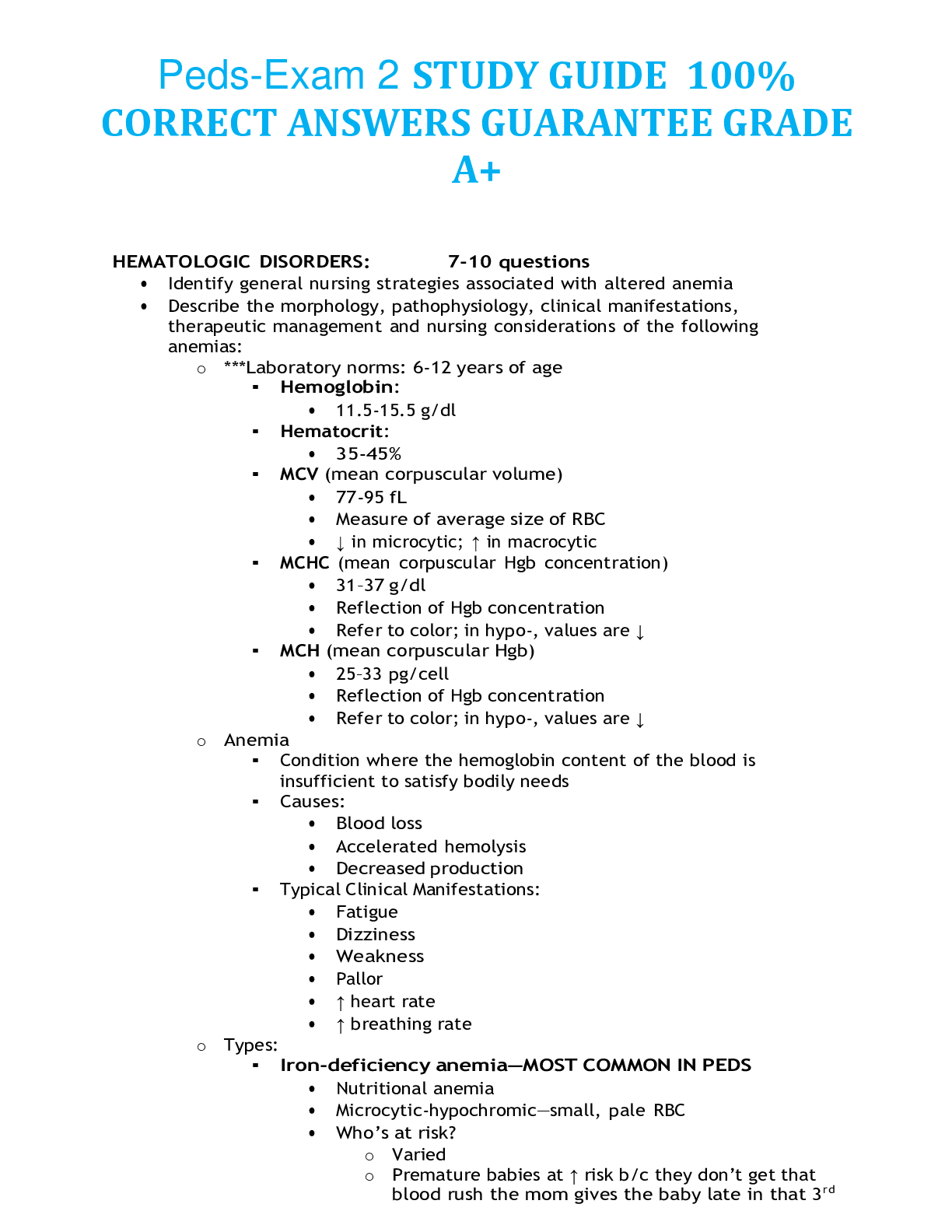
Buy this document to get the full access instantly
Instant Download Access after purchase
Buy NowInstant download
We Accept:

Reviews( 0 )
$14.00
Can't find what you want? Try our AI powered Search
Document information
Connected school, study & course
About the document
Uploaded On
Oct 05, 2021
Number of pages
56
Written in
Additional information
This document has been written for:
Uploaded
Oct 05, 2021
Downloads
0
Views
62

